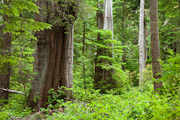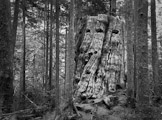|
July 2009: Overnight on Long Island in Willapa Bay |
|
Willapa Bay Willapa Bay is a large saltwater bay on the southwest coast of Washington State. The bay is separated from the Pacific ocean by a thin spit of sand that's home to the community of Long Beach. |
|
Long Island Long Island is located in the south part of Willapa Bay. This island was once heavily logged, but now is a National Wildlife Refuge, only accessible by boat. Old logging roads now serve as trails, connecting a number of developed campgrounds along the shore. |
|
Don Bonker Cedar Grove Don Bonker was a congressional respresentative from 1975-1998. He helps get Long Island protected as part of the Willapa Bay National Wildlife Refuge. Only one small bit of old growth cedar remains on Long Island. It'll take hundreds of years for the rest of the island to recover to its natural state. |
|
Red Huckleberries Red Huckleberries grow below the old trees, giving a dash of color, and serving a tasty treat. |
|
Old Trees The Western Redcedar (seen here at the left of this photo) is the dominant large tree in this forest. |
|
Memorial Sadly, this is all that remains of most of the big trees on Long Island. The place was denuded in persuit of cheap wood. These large trees take many hundreds of years to achieve their size, and were chopped down to be used mostly as cedar shingle roofing... which lasts maybe 10-15 years before being discarded. Surely, our society needs wood; but to destroy such a majestic piece of history for such a purpose is simply tragic. |
|
Hope Perhaps this generation's legacy will not be stumps of dead trees, but rather a living monument - a gift to the future, which we'll never fully witness. |
Where is it? Willapa Bay is located in the southwest of Washington State. Long Island is in the south part of the bay, and only accessible by boat. Willapa Bay opens to the Pacific Ocean on the north side. |
Before you go... Some parts of Willapa Bay are very shallow. Be sure to consult the tide charts before planning your trip. If the tide is below 5ft high, you risk getting stuck on a mudflat until the next high tide. The tides also create a current... when the tide is going out, flow is to the north. When the tide is coming in, flow is to the south. |







